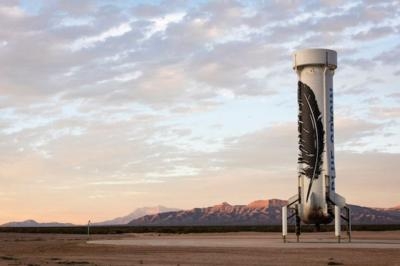Wed, Nov 25, 2015
Only Time Will Tell If The Booster Is Truly Reusable
News/Analysis By Wes Oleszewski
On November 23, 2015 Blue Origin achieved a first in rocketry and spaceflight history when their New Shepard launch vehicle successfully delivered a payload across the official boundary of space and then returned to Earth to land upright under rocket power.

Working in near secrecy and well out of sight of the media Blue Origin has netted engineering results that gave the company the opportunity to reach this unique milestone. While landing a large rocket powered vehicle upright had been done in the past both with the McDonnell Douglas DC-X in the 1990s and with SpaceX’s Grasshopper more recently, neither vehicle was designed to reach space with a payload. SpaceX has tried twice to land the first stage of its Falcon 9 launch vehicle and failed each time. Blue Origin also failed in its first attempt to land the New Shepard booster on April 29, 2015. Yet the bugs seem to be fully worked out of their system this time.
New Shepard landed just 4.5 feet from the dead center of the target at a touchdown speed of just 4.4 miles per hour. This after boosting the vehicle’s spacecraft in a high altitude toss to an altitude of 329,839 feet, or 100.5 Km which is just beyond the internationally recognized boundary of “space.” The flight was launched from Blue Origin’s secluded West Texas launch site shortly after the hour of noon Eastern time.
In spite of scores of SpaceX fans who have scoffed at Blue Origin’s ability to achieve the historic milestone that their favored space company has failed to meet, the fact is that this is a spaceflight first. At this moment Blue Origin has in their possession a flight ready booster that has been flown and can now be flown again. That task was accomplished without a legion of internet fans, without a huge influx of NASA funds and without a doughnut wall.

Yet the questions now remain, how re-useable will be this re-usability? Will the New Shepard vehicles be able to safely and reliably fly passengers beyond the space boundary over and over to the point where the company can actually earn money? Or, will the system suffer the same myth of re-usability that the Space Shuttle experienced? Granted, the sub-orbital system is far less complex in countless ways including fuels and operational environment, but there are always factors that sap the bottom line in any flying venture.
For now, however, the team at Blue Origin has made spaceflight history and no one can ever take that away from them. I only wish that they would have let us all watch it live rather than telling us afterward in Soviet-like space tradition.
(Images provided by Blue Origin)
More News
From 2023 (YouTube Version): Legacy of a Titan Robert (Bob) Anderson Hoover was a fighter pilot, test pilot, flight instructor, and air show superstar. More so, Bob Hoover was an i>[...]
Get The Latest in Aviation News NOW on Instagram Are you on Instagram yet? It's been around for a few years, quietly picking up traction mostly thanks to everybody's new obsession >[...]
Aero Linx: B-52H Stratofortress The B-52H Stratofortress is a long-range, heavy bomber that can perform a variety of missions. The bomber is capable of flying at high subsonic spee>[...]
Altimeter Setting The barometric pressure reading used to adjust a pressure altimeter for variations in existing atmospheric pressure or to the standard altimeter setting (29.92).>[...]
"Knowing that we play an active part in bettering people's lives is extremely rewarding. My team and I are very thankful for the opportunity to be here and to help in any way we ca>[...]
 Classic Aero-TV: Remembering Bob Hoover
Classic Aero-TV: Remembering Bob Hoover ANN FAQ: Follow Us On Instagram!
ANN FAQ: Follow Us On Instagram! ANN's Daily Aero-Linx (05.15.24)
ANN's Daily Aero-Linx (05.15.24) ANN's Daily Aero-Term (05.15.24):Altimeter Setting
ANN's Daily Aero-Term (05.15.24):Altimeter Setting Aero-News: Quote of the Day (05.16.24)
Aero-News: Quote of the Day (05.16.24)




